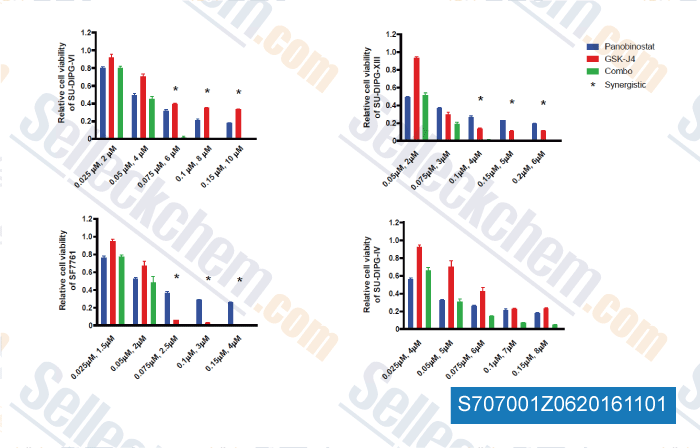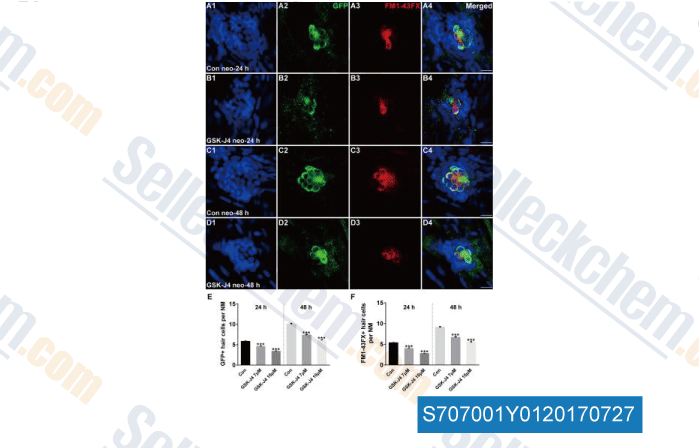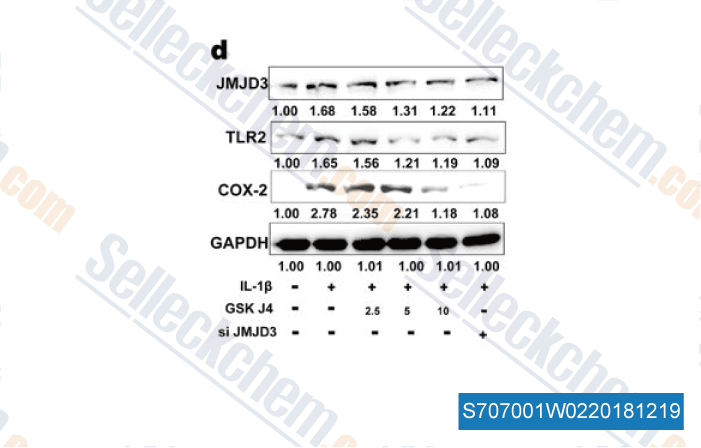|
Toll Free: (877) 796-6397 -- USA and Canada only -- |
Fax: +1-832-582-8590 Orders: +1-832-582-8158 |
Tech Support: +1-832-582-8158 Ext:3 Please provide your Order Number in the email. |
Technical Data
| Formula | C24H27N5O2.HCl |
||||||
| Molecular Weight | 453.96 | CAS No. | 1797983-09-5 | ||||
| Solubility (25°C)* | In vitro | DMSO | 91 mg/mL (200.45 mM) | ||||
| Ethanol | 91 mg/mL (200.45 mM) | ||||||
| Water | 9.4 mg/mL (20.7 mM) | ||||||
| In vivo (Add solvents to the product individually and in order) |
|
||||||
|
* <1 mg/ml means slightly soluble or insoluble. * Please note that Selleck tests the solubility of all compounds in-house, and the actual solubility may differ slightly from published values. This is normal and is due to slight batch-to-batch variations. * Room temperature shipping (Stability testing shows this product can be shipped without any cooling measures.) |
|||||||
Preparing Stock Solutions
Biological Activity
| Description | GSK J4 HCl is a cell permeable prodrug of GSK J1, which is the first selective inhibitor of the H3K27 histone demethylase JMJD3 and UTX with IC50 of 60 nM in a cell-free assay and inactive against a panel of demethylases of the JMJ family. | ||
|---|---|---|---|
| Targets |
|
||
| In vitro | GSK J4 HCl is an ethyl ester derivative of the JMJD3 selective histone demethylase inhibitor GSK-J1 with an IC50 value greater than 50 μM in vitro. GSK J4 HCl is used to probe the consequences of demethylation of H3K27me3. In human primary macrophages, GSK-J4 inhibits the lipopolysaccharide-induced production of cytokines, including pro-inflammatory tumour necrosis factor (TNF). In addition, GSK-J4 prevents the lipopolysaccharide-induced loss of H3K27me3 associated with the TNF transcription start sites and blocked the recruitment of RNA polymerase II. [1] |
||
| In vivo | GSK-J4 hydrochloride is a potent dual inhibitor of H3K27me3/me2-demethylases JMJD3/KDM6B and UTX/KDM6A. It inhibits LPS-induced TNF-α production in human primary macrophages. GSK-J4 hydrochloride is a cell permeable prodrug of GSK-J1. |
Protocol (from reference)
| Kinase Assay: |
|
|---|---|
| Cell Assay: |
|
| Animal Study: |
|
References
|
Customer Product Validation

-
, , Nat Med, 2015, 21(6):555-9.

-
, , Front Mol Neurosci, 2017, doi: 10.3389/fnmol.2017.00051

-
Data from [Data independently produced by , , Cell Mol Immunol, 2018, doi:10.1038/s41423-018-0037-8]

-
Data from [Data independently produced by , , FASEB J, 2018, 32(7):4031-4042]
Selleck's GSK J4 HCl has been cited by 67 publications
| Loss of Kmt2c or Kmt2d drives brain metastasis via KDM6A-dependent upregulation of MMP3 [ Nat Cell Biol, 2024, 26(7):1165-1175] | PubMed: 38926506 |
| Evi1 governs Kdm6b-mediated histone demethylation to regulate the Laptm4b-driven mTOR pathway in hematopoietic progenitor cells [ J Clin Invest, 2024, 134(24)e173403] | PubMed: 39680456 |
| Targeting lysine demethylase 6B ameliorates ASXL1 truncation-mediated myeloid malignancies in preclinical models [ J Clin Invest, 2024, 134(1)e163964] | PubMed: 37917239 |
| Refractory testicular germ cell tumors are highly sensitive to the targeting of polycomb pathway demethylases KDM6A and KDM6B [ Cell Commun Signal, 2024, 22(1):528] | PubMed: 39482699 |
| Dual targeting of histone deacetylases and MYC as potential treatment strategy for H3-K27M pediatric gliomas [ Elife, 2024, 13RP96257] | PubMed: 39093942 |
| Prenatal dexamethasone exposure reduces osteoprogenitor proliferation in mice via histone modifications at the Mkp-1 gene locus [ Commun Biol, 2024, 7(1):1589] | PubMed: 39609620 |
| Targeting histone demethylases JMJD3 and UTX: selenium as a potential therapeutic agent for cervical cancer [ Clin Epigenetics, 2024, 16(1):51] | PubMed: 38576048 |
| miRNA-27a-3p is involved in the plasticity of differentiated hepatocytes [ Gene, 2024, 913:148387] | PubMed: 38499211 |
| Refractory testicular germ cell tumors are highly sensitive to the targeting of polycomb pathway demethylases KDM6A and KDM6B [ Res Sq, 2024, rs.3.rs-4986186] | PubMed: 39483904 |
| Hedgehog pathway orchestrates the interplay of histone modifications and tailors combination epigenetic therapies in breast cancer [ Acta Pharm Sin B, 2023, 13(6):2601-2612] | PubMed: 37425067 |
RETURN POLICY
Selleck Chemical’s Unconditional Return Policy ensures a smooth online shopping experience for our customers. If you are in any way unsatisfied with your purchase, you may return any item(s) within 7 days of receiving it. In the event of product quality issues, either protocol related or product related problems, you may return any item(s) within 365 days from the original purchase date. Please follow the instructions below when returning products.
SHIPPING AND STORAGE
Selleck products are transported at room temperature. If you receive the product at room temperature, please rest assured, the Selleck Quality Inspection Department has conducted experiments to verify that the normal temperature placement of one month will not affect the biological activity of powder products. After collecting, please store the product according to the requirements described in the datasheet. Most Selleck products are stable under the recommended conditions.
NOT FOR HUMAN, VETERINARY DIAGNOSTIC OR THERAPEUTIC USE.
